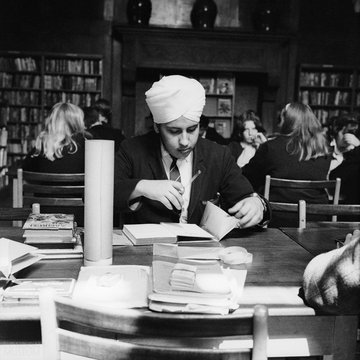
Education
Educational institutions, such as schools and universities, and educational practices, such as who and what has been taught, were all shaped by South Asians in Britain
Overview
Many South Asians have travelled to the United Kingdom to further their education. The first universities in British India were established in 1857 and from that period a steady stream of South Asians have studied at British universities, developing new student societies, like the Oxford and Cambridge Majlis or Edinburgh Indian Association, that helped foster new networks and connections. By 1921 there were over 1,000 Indian students studying across the United Kingdom, and the government commissioned the Lytton Report to investigate ways to support them and encourage them to engage with all aspects of university life. Students in the nineteenth century were particularly interested in vocational subjects such as law and medicine, with famous examples such as M. K. Gandhi, Pherozeshah Mehta, Badruddin Tyabji and W. C. Bonnerjee all training as barristers in London and going on to take leading roles in the Indian National Congress.
South Asians opened up British educational institutions in new ways – Cornelia Sorabji was the first woman, of any nationality or ethnicity, to study law at Oxford University (in 1889) and Mithan Lam (née Tata) was one of the first women, of any nationality or ethnicity, to be called to the Bar (in 1921). Ardaseer Cursetjee was the first Indian Fellow elected to the Royal Society of London in 1841, for his work on marine engineering. Dadabhai Naoroji’s ‘drain theory’ on how wealth was being drained from India under empire remains crucial to economic theory today, S. Ramanujan ‘discovered’ infinity and S. Chandrasekhar’s work was crucial to understanding black holes.
Meanwhile, children of South Asian heritage have been attending British schools since at least the 1830s. They have been an integral part of British social, cultural and community life. Schoolteachers such as Rozina Visram have also been instrumental in education and opening up the histories of South Asian Britain. There have been community attempts to broaden access to education, such as the Ethnic Minority Business Service Community College in Oxford, set up in 1988.
South Asians have also engaged in arts education and artistic practice. Fanindranath Bose studied at the Board of Manufacturers School of Edinburgh and was later elected to the Royal Scottish Academy before his death in 1926. Sutapa Biswas studied fine art and art history at the University of Leeds between 1981 and 1985 and then lectured in fine art alongside her artistic practice.
The successes and connections of South Asians in education continued into the twenty-first century with influential figures such as the economist Amartya Sen and the writer and feminist Pratibha Parmar. Academics of South Asian heritage include Numair Masud and Nisha Ramayya. Dame Bobbie Cheema-Grubb, the daughter of a seamstress, became the UK’s first High Court judge of South Asian heritage in 2015.
Another interesting thing
Black and South Asian children were ‘bussed’ out from their local areas into schools in the 1960s and 1970s in the hope that they would integrate better with other children, although it actually created more segregation and discrimination. This practice took place in Blackburn, Bradford, Bristol, Southall, Halifax, Hounslow, Huddersfield, Leicester, Luton, Walsall and West Bromwich. 'Bussing out' ended in 1980.
Browse this theme
Image credit
A Sikh student studying in the library at Holland Park Comprehensive, by Henry Grant, HG1933/72, © Henry Grant Collection/London Museum, https://creativecommons.org/licenses/by-nc/4.0/
